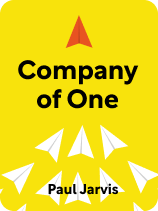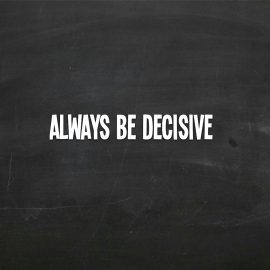
What exactly is a one-person business? How is it different from other types of companies? Is it the right choice for you?
In Company of One, Paul Jarvis advocates for one-person businesses that limit their growth and focus on creating quality products and services. He argues that, by owning such a company, you can exercise more control over your work and form meaningful, successful relationships with customers.
Read more to learn the three main characteristics of a one-person business.
Characteristics of a One-Person Business
Jarvis discusses the reasons not to push your company toward fast, unsustainable growth, and he presents an alternative path. According to Jarvis, a one-person business focuses on simplicity and stability. As the owner of a one-person business, your primary goal is to make enough revenue to pay yourself a salary and cover your business expenses.
(Shortform note: In The $100 Startup, Chris Guillebeau describes a company type in between Jarvis’s one-person business model and a large, growth-focused company. He states that a mid-sized company model allows you to expand your business and reach a wider audience without the constraints of larger corporations or mass markets. You might hire more employees than you would as the owner of a one-person business to meet the demand for your product, but you still don’t outsource the creation or distribution of your product. You still pay your salary and expenses, and your business makes a higher profit.)
Over time, you may slowly grow your company’s profit as the quality of your products and services draws in more customers. However, you consciously limit this growth by limiting the number of clients or customers you take on and limiting your revenue goals. Running the company yourself remains manageable.
| Benefits, Drawbacks, and Strategies of Limiting Business Growth Jarvis’s description of a one-person business is similar to a limited growth strategy: a business model in which a company focuses on spending minimally and growing sustainably. Experts argue that there are advantages and disadvantages to this model. On one hand, your company won’t take on huge amounts of debt, and you’ll likely be able to keep your business going without it taking over your personal life. On the other hand, companies of limited size often can’t take advantage of the savings and discounts that come with buying inventory in bulk. Likewise, your production systems may be inefficient because of the small volume of products you produce, and you may struggle to gain market share. When identifying financial goals as the owner of a one-person or limited growth company (including those aimed at limiting your company’s revenue), some experts suggest making them as specific and concrete as possible. For example, you might set a revenue goal of $300,000 in one year. Such specific goals help you more easily track progress, and they keep you motivated. Then, create a detailed plan including specific steps needed to reach your revenue goals. For a one-person business, this may include actions that ensure you stay within your stated revenue goals, instead of exceeding them. Finally, track your spending. This could be especially important for a one-person business, as you have limited funds to work with and no cushion for overspending. When it comes to limiting clients and customers (and reaching revenue goals), one strategy is raising your prices slightly, especially on your most popular products and services. If you have more clients than you can take on, you know the demand for your product or service is there, and a small price increase likely won’t turn away loyal customers. However, it will likely drive some potential customers elsewhere, making your client list more manageable. |
Jarvis describes three primary characteristics that define a one-person business and its owner:
Characteristic #1: De-Emphasis on Growth
Jarvis states that a core aspect of a one-person business is its de-emphasis on growth. Instead of solving problems by spending more money and acquiring more resources as traditional growth-focused companies do, one-person businesses find solutions using their existing resources.
For example, a growth-focused company might solve the problem of how to attract more customers by increasing the money it spends on advertising. Additionally, it might hire more marketing employees to create strategies for customer acquisition, with the ultimate goal being to increase the size and profits of the company.
In contrast, the owner of a one-person business wouldn’t spend more money or hire more employees to expand its customer base—they would instead focus on creating a high-quality service or product. The better a service or product is, the more likely it is that customers will recommend it to their friends. Over time, the company’s network of clients and customers increases through word of mouth.
(Shortform note: Using your existing resources to save money as a business owner is often a matter of researching and educating yourself on free or low-cost tools. For example, if your company requires software, skip the pricier options like Photoshop, Quickbooks, and Microsoft Office. Instead, research free options that work just as well. When considering advertising, avoid costly traditional options like TV commercials and familiarize yourself with social media and SEO techniques. These options can drive traffic to your business without you having to spend anything.)
Characteristic #2: Adaptability to Changing Circumstances
Jarvis says one-person businesses can adapt to changing circumstances and endure hardship. One challenge may be market changes caused by world events or new technologies. With an adaptive, resilient mindset, owners of one-person businesses can pivot more easily when they encounter such challenges than larger companies can.
One-person businesses are adaptable to hardship and changing circumstances because they typically have a strong purpose, not just the desire to make money. This purpose stems from your values as the owner—the reasons you do the work apart from profit. For example, your company’s purpose might be to support social and economic justice, help people advance their careers, or promote sustainability.
Characteristic #3: Increased Independence and Control
According to Jarvis, owning a one-person business also gives you more independence than you’d have as the owner of a fast-growing company or an employee at someone else’s company. Because your business stays intentionally small (meaning you’re likely the only one working there) and uses existing resources to solve problems, you have complete creative, financial, and administrative control. Therefore, you get to decide how often you work, when you work, who you work with, and so on.
For example, say you’re a graphic designer. If you’re working at a firm, management determines your projects and clients. You have to prioritize your work based on what other people want from you. However, if you own your own graphic design company, you can choose your clients and decide how many projects to take on at any given time.
Exercise: Develop an Idea for a Single-Person Company
Jarvis offers insights into the potential benefits of owning a single-person company. Start developing an idea for your own company.
- Write down an idea for a business you could turn into a single-person company. (For example, maybe you want to start a personal training business or a business as a professional meal prepper.)
- Which of the characteristics of single-person companies appeals to you the most? (For example, you might want to set your own schedule, so the independence of owning a single-person company appeals to you. Or, maybe the focus on staying small makes you feel less overwhelmed about the prospect of running a business.)
- What are three skills you’d need before starting your single-person company? (For example, for the personal training business, you’d need an understanding of fitness techniques, strong interpersonal skills, and some marketing skills. For the meal prep business, you’d need a decent repertoire of recipes, solid cooking skills, and experience with client relations.)
- From the three you chose, pick one skill that you need to develop more. Write a brief plan for how you might go about this. (For example, say you need to improve your knowledge of fitness techniques before starting your personal training business. You might develop this skill by getting a job at a gym and learning from more experienced trainers, or by reading books on the subject.)

———End of Preview———
Like what you just read? Read the rest of the world's best book summary and analysis of Paul Jarvis's "Company of One" at Shortform.
Here's what you'll find in our full Company of One summary:
- Why growth-focused companies don't always work
- Why single-person companies often excel in quality and service
- Tips on how to get started with your own single-person company






